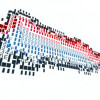Breakthrough Brings Quantum Computers Closer To Reality
Researchers from two National Science Foundation (NSF)-funded Materials Research Science and Engineering Centers at Princeton University and the University of California, Santa Barbara made a significant breakthrough in the worldwide pursuit of quantum computing. They engineered a method to control the spin of a single electron within a magnetic field without disturbing other nearby electrons.
The method developed by a team of researchers led by Jason Petta, assistant professor of physics at Princeton University with partial support from his NSF Faculty Early Career Development Award, traps one or two electrons in microscopic corrals created by applying voltages to minuscule electrodes giving them an ability to control spin orientation.
The accomplishment overcomes a major challenge to creating scalable semiconductor-based quantum computers that use the intrinsic spin of individual electrons to store and manipulate information. Previous methods, namely electron spin resonance or ESR, unselectively sprayed microwave radiation on a sample, causing all the electrons in the sample to adopt the same spin orientation. This defeated the goal of having distinct electrons work together to represent data.









































































